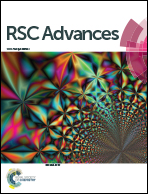Synthesis and NOx sensing evaluation of hollow/porous La0.8Sr0.2MnO3 microspheres†
Abstract
To improve the nitric oxide (NO) gas reaction properties, we synthesized microspherical La0.8Sr0.2MnO3 (LSM) particles. We investigated the NO sensing properties of NOx sensors fabricated using electrodes based on hollow/porous LSM (hp-LSM) and solid sphere LSM particles. The hp-LSM particles were synthesized using a novel process combining spray pyrolysis with carbonization using citric acid. The resulting particles were characterized by X-ray diffraction (XRD), and scanning electron microscopy (SEM), and their specific surface area was estimated using Brunauer–Emmett–Teller (BET) theory. The particle and pore size of the hp-LSM particles were estimated to be 1–3 μm and 100–500 nm, respectively, and their highest specific surface area was determined to be 6.8 m2 g−1. Sintered pellets made from hp-LSM particles had a relative density of 68% and a broad pore size distribution between 100 and 1000 nm, estimated by the Archimedes method and mercury intrusion porosimetry measurements. The hp-LSM-based gas sensing electrode exhibited a faster NO response/recovery time than the one based on solid LSM. This synthetic method is expected to be widely applicable to other materials, and hollow/porous particles may be used for various applications such as gas sensors, batteries and chemical reactors.


 Please wait while we load your content...
Please wait while we load your content...